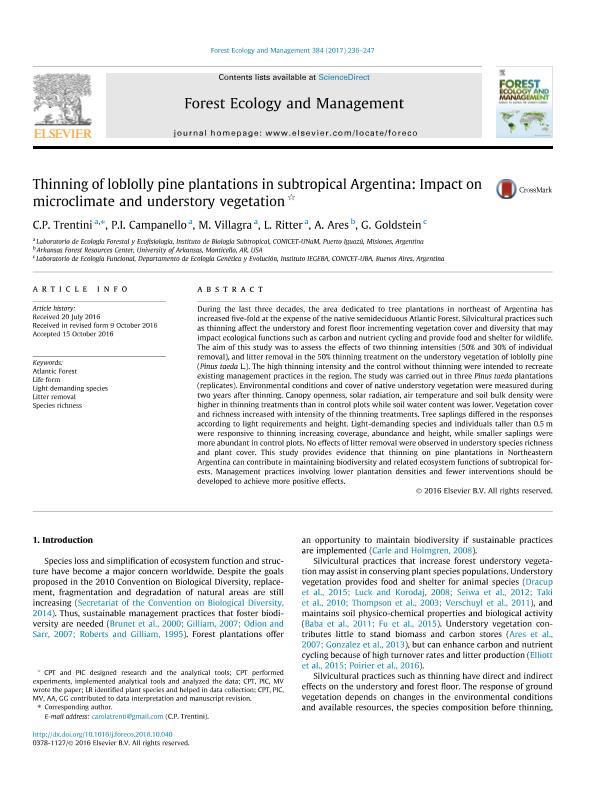Mostrar el registro sencillo del ítem
dc.contributor.author
Trentini, Carolina Paola

dc.contributor.author
Campanello, Paula Inés

dc.contributor.author
Villagra, Mariana

dc.contributor.author
Ritter, Luis Javier

dc.contributor.author
Ares, A.
dc.contributor.author
Goldstein, Guillermo Hernan

dc.date.available
2018-05-11T20:45:27Z
dc.date.issued
2017-01
dc.identifier.citation
Trentini, Carolina Paola; Campanello, Paula Inés; Villagra, Mariana; Ritter, Luis Javier; Ares, A.; et al.; Thinning of loblolly pine plantations in subtropical Argentina: Impact on microclimate and understory vegetation; Elsevier Science; Forest Ecology and Management; 384; 1-2017; 236-247
dc.identifier.issn
0378-1127
dc.identifier.uri
http://hdl.handle.net/11336/44990
dc.description.abstract
During the last three decades, the area dedicated to tree plantations in northeast of Argentina has increased five-fold at the expense of the native semideciduous Atlantic Forest. Silvicultural practices such as thinning affect the understory and forest floor incrementing vegetation cover and diversity that may impact ecological functions such as carbon and nutrient cycling and provide food and shelter for wildlife. The aim of this study was to assess the effects of two thinning intensities (50% and 30% of individual removal), and litter removal in the 50% thinning treatment on the understory vegetation of loblolly pine (Pinus taeda L.). The high thinning intensity and the control without thinning were intended to recreate existing management practices in the region. The study was carried out in three Pinus taeda plantations (replicates). Environmental conditions and cover of native understory vegetation were measured during two years after thinning. Canopy openness, solar radiation, air temperature and soil bulk density were higher in thinning treatments than in control plots while soil water content was lower. Vegetation cover and richness increased with intensity of the thinning treatments. Tree saplings differed in the responses according to light requirements and height. Light-demanding species and individuals taller than 0.5 m were responsive to thinning increasing coverage, abundance and height, while smaller saplings were more abundant in control plots. No effects of litter removal were observed in understory species richness and plant cover. This study provides evidence that thinning on pine plantations in Northeastern Argentina can contribute in maintaining biodiversity and related ecosystem functions of subtropical forests. Management practices involving lower plantation densities and fewer interventions should be developed to achieve more positive effects.
dc.format
application/pdf
dc.language.iso
eng
dc.publisher
Elsevier Science

dc.rights
info:eu-repo/semantics/openAccess
dc.rights.uri
https://creativecommons.org/licenses/by-nc-sa/2.5/ar/
dc.subject
Atlantic Forest
dc.subject
Life Form
dc.subject
Light Demanding Species
dc.subject
Litter Removal
dc.subject.classification
Otras Ciencias Biológicas

dc.subject.classification
Ciencias Biológicas

dc.subject.classification
CIENCIAS NATURALES Y EXACTAS

dc.title
Thinning of loblolly pine plantations in subtropical Argentina: Impact on microclimate and understory vegetation
dc.type
info:eu-repo/semantics/article
dc.type
info:ar-repo/semantics/artículo
dc.type
info:eu-repo/semantics/publishedVersion
dc.date.updated
2018-05-04T20:17:45Z
dc.identifier.eissn
0378-1127
dc.journal.volume
384
dc.journal.pagination
236-247
dc.journal.pais
Países Bajos

dc.journal.ciudad
Amsterdam
dc.description.fil
Fil: Trentini, Carolina Paola. Consejo Nacional de Investigaciones Científicas y Técnicas. Centro Científico Tecnológico Conicet - Nordeste. Instituto de Biología Subtropical. Instituto de Biología Subtropical - Nodo Puerto Iguazú | Universidad Nacional de Misiones. Instituto de Biología Subtropical. Instituto de Biología Subtropical - Nodo Puerto Iguazú; Argentina
dc.description.fil
Fil: Campanello, Paula Inés. Consejo Nacional de Investigaciones Científicas y Técnicas. Centro Científico Tecnológico Conicet - Nordeste. Instituto de Biología Subtropical. Instituto de Biología Subtropical - Nodo Puerto Iguazú | Universidad Nacional de Misiones. Instituto de Biología Subtropical. Instituto de Biología Subtropical - Nodo Puerto Iguazú; Argentina
dc.description.fil
Fil: Villagra, Mariana. Consejo Nacional de Investigaciones Científicas y Técnicas. Centro Científico Tecnológico Conicet - Nordeste. Instituto de Biología Subtropical. Instituto de Biología Subtropical - Nodo Puerto Iguazú | Universidad Nacional de Misiones. Instituto de Biología Subtropical. Instituto de Biología Subtropical - Nodo Puerto Iguazú; Argentina
dc.description.fil
Fil: Ritter, Luis Javier. Consejo Nacional de Investigaciones Científicas y Técnicas. Centro Científico Tecnológico Conicet - Nordeste. Instituto de Biología Subtropical. Universidad Nacional de Misiones. Instituto de Biología Subtropical; Argentina
dc.description.fil
Fil: Ares, A.. University of Arkansas; Estados Unidos
dc.description.fil
Fil: Goldstein, Guillermo Hernan. Consejo Nacional de Investigaciones Científicas y Técnicas. Oficina de Coordinación Administrativa Ciudad Universitaria. Instituto de Geociencias Básicas, Aplicadas y Ambientales de Buenos Aires. Universidad de Buenos Aires. Facultad de Ciencias Exactas y Naturales. Instituto de Geociencias Básicas, Aplicadas y Ambientales de Buenos Aires; Argentina
dc.journal.title
Forest Ecology and Management

dc.relation.alternativeid
info:eu-repo/semantics/altIdentifier/url/https://www.sciencedirect.com/science/article/pii/S0378112716308106
dc.relation.alternativeid
info:eu-repo/semantics/altIdentifier/doi/http://dx.doi.org/10.1016/j.foreco.2016.10.040
Archivos asociados
